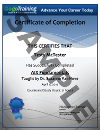In this course students learn the basics of writing Oracle SQL statements. This course provides the SQL skills that allow developers, database administrators and end-users to write queries against single and multiple tables, manipulate data in tables and take advantage of Oracle supplied row functions.
View all course details
Module 00: Oracle 11g/12c: Introduction to SQL Online Training - Course Introduction
Module 01: Writing SQL SELECT Statements
- Review the basic SQL SELECT statement syntax
- Select all columns using a wildcard notation from a table
- Valid SELECT statement expressions
- Write a query containing the arithmetic operators
- Use aliases to customize column headings
- Create a character expression with the concatenation operator
- Use the CASE Expression
- Lab Exercise
Module 02: Writing SQL SELECT Statements Demo
Module 03: Restricting Data
- Use the WHERE Clause
- WHERE clause operators
- =, <>, >, < operators
- BETWEEN, IN, LIKE, IS NULL operators
- Adding ANY or ALL to an operator
- List the Logical Conditions AND, OR, NOT
- Use Multiple Conditions in the WHERE clause
- Describe the Rules of Precedence
- Lab Exercise
Module 04: Restricting Data Demo
Module 05: Sorting Data
- Discuss default order of result sets
- Sort Rows with the ORDER BY Clause
- ORDER BY valid expressions
- DISTINCT and UNIQUE clauses
- Lab Exercise
Module 06: Sorting Data Demo
Module 07: Displaying Data from Multiple Tables
- Identify Types of Joins
- ANSI standard join operators vs. non-standard join methods
- Using the non-standard join methods
- Inner join vs. Outer join
- Generating a Cartesian Product
- ANSI standard join operators
- NATURAL JOIN, JOIN USING, JOIN ON, LEFT/RIGHT/FULL OUTER joins
- Lab Exercise
Module 08: Displaying Data from Multiple Tables Demo
Module 09: Character Row Functions
- Categories of row functions
- Statement behavior of row functions
- Useful / common character row functions
- Nest Functions to perform multiple tasks in one statement
- Lab Exercise
Module 10: Character Row Functions Demo
Module 11: Numeric Row Functions
- Where numeric row functions can and cannot be used
- Helpful numeric row functions in SQL statements
- Functionalities of common numeric row functions
- Explain Implicit and Explicit conversion
- Lab Exercise
Module 12: Numeric Row Functions Demos
Module 13: Date/Time Row Functions
- Where date/time row functions can and cannot be used
- Helpful date/time row functions in SQL statements
- Functionalities of common date/time row functions
- Lab Exercise
Module 14: Date/Time Row Functions Demo
Module 15: Miscellaneous Row Functions
- Using conversion functions
- Using conversion functions to format date/time data
- Environment and Data specific row functions
- The Decode function versus the Case Option
- Lab Exercise
Module 16: Miscellaneous Row Functions Demo
Module 17: Aggregating Data Using Group Functions
- Categorize the Types of Group Functions
- Use the AVG, SUM, MAX, MIN, and COUNT Functions in a Query
- Utilize the DISTINCT Keyword with the Group Functions
- Describe how Nulls are handled with the Group Functions
- Create Groups of Data with the GROUP BY Clause
- Group Data by more than one column
- Exclude Groups of Data with the HAVING Clause
- Differences between the HAVING clause and the WHERE clause
- Lab Exercise
Module 18: Aggregating Data Using Group Functions Demo
Module 19: Extensions to the GROUP BY Clause
- Using the CUBE option
- Using the ROLLUP option
- CUBE vs. ROLLUP output
- The GROUPING BY option
- Lab Exercise
Module 20: Extensions to the GROUP BY Clause Demo
Module 21: Manipulating Data I
- Write INSERT statements to add rows to a table
- Insert Special Values
- Copy Rows from Another Table
- Update Rows in a Table
- Use DELETE statements to remove rows from a table
- Delete Rows Based on Another Table
- The COMMIT and ROLLBACK statements
- Using the SAVEPOINT statement
- Lab Exercise
Module 22: Manipulating Data I Demo
Module 23: Manipulating Data II
- Describe the TRUNCATE Statement
- TRUNCATE vs. DELETE
- Using the Multi-table INSERT statement
- Using the MERGE statement
- Show how Read Consistency works
- Lab Exercise
Module 24: Manipulating Data II Demo
Module 25: 12c New Features
- Top-n Query
- Cascading Truncate Statement
- Native Left Outer Join
View all course details


